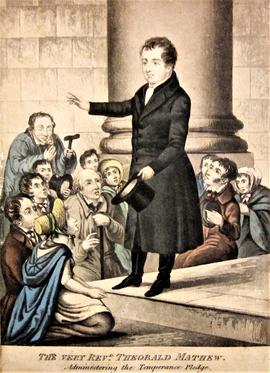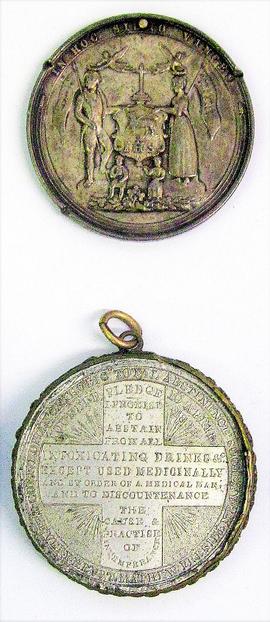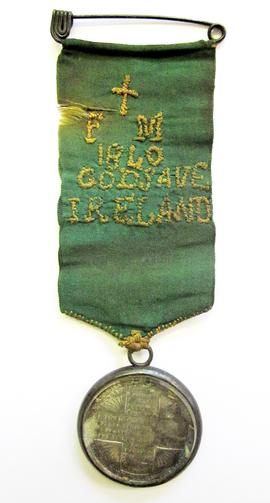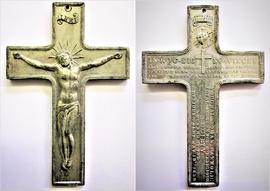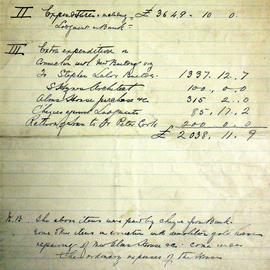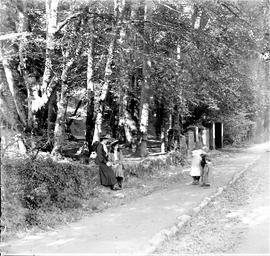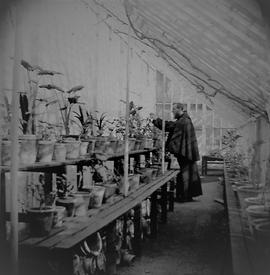• Flier for the Dublin Total Abstinence Society advertising its work and various events. It reads ‘The Dublin Total Abstinence Society was the oldest Society in the City, and the late James Haughton Esq., was the President. … It is a pleasing fact, and worthy of record, that still the friendship exists between the Haughton family and the Society; and the donation of £150, which the Society has received from the four legatees of the late Miss Lizzie Haughton, proves the interest the family still take in the principles which their father advocated for many years in the city’. Reference is made to the three ‘coffee palaces’ and to two large temperance halls (one in Dublin and one in Kingstown). The flier dates to 1885. The reverse of the flier reprints a ‘Great Temperance Procession Poster’ of March 1841. Printed. 2 pp.
• Notebook containing newspaper clippings relating to the League of the Sacred Thirst attached to St. Mary of the Angels, Church Street, Dublin’. An annotation on the first page reads ‘I began this League of the “Sacred Thirst” in June [1880] in our Church of the Lady of the Angels, Church Street, the men meet on Mondays and the women on Wednesday evenings. Fr. Albert Mitchell OSFC’. The clippings date from 10 Sept. 1880 to 23 Sept. 1881 and report meetings of this Temperance Sodality in Church Street and in the temperance hall on Halston Street. Some annotations and comments by Fr. Mitchell are added to the notebook. Clippings, 20 pp.
• Clipping referring to an endowment of $25,000 from the Catholic Total Abstinence Union of America for the establishment of the ‘Father Mathew Chair of Psychology’ at the Catholic University of America, Washington. [c.1930]. Clipping, 2 pp.
• Copy flier for The Father Mathew Hall, Church Street, Dublin, which ‘aims at promoting sobriety and providing instruction and healthful amusement for boys and men’. c.1935. Printed, 1 p.
Colour print showing Fr. Theobald Mathew OSFC administering the pledge (probably at the Custom House, Dublin). The caption reads: ‘The Very Revd. Theobald Mathew / Administering the Temperance Pledge / I promise to abstain from all intoxicating drinks &c except used medicinally, and by order of a medical man, and to discountenance the cause and practice of intemperance / Prayer / May God bless you and enable you to keep your promise’. The frame backing has a printed flier from the ‘Association of Men of the Most Sacred Heart of Jesus / Church of St. Kevin, Harrington Street, A.D. 1914’.
Total Abstinence Society of Ireland Medal
c.1840-1850
Diameter: 4.5 cm
Pewter Medal in Glass
Physical Description:
• Face (front): In relief, Fr. Mathew addresses kneeling crowd. Outer rim inscription reads: ‘May God bless you and grant you grace and strength to keep your promise’.
Obverse: Cruciform formula of pledge: ‘I / Promise / by the / Help of / God/ to abstain from all / intoxicating drinks / except used medicinally / and to discountenance the / cause and practice / of / intemperance’. Outer edge inscription reads: ‘The Very Rev. T. Mathew, President / The Total Abstinence Society of Ireland’.
The medal has fragments of a green ribbon and pin attached.
Total Abstinence Society of Ireland Medal
c.1840-1850
Diameter: 4.5 cm
Pewter Medal in Glass
Physical Description:
• Face (front): In relief, Fr. Mathew addresses kneeling crowd. Outer rim inscription reads: ‘May God bless you and grant you grace and strength to keep your promise’.
Obverse: Cruciform formula of pledge: ‘I / Promise / by the / Help of / God/ to abstain from all / intoxicating drinks / except used medicinally / and to discountenance the / cause and practice / of / intemperance’. Outer edge inscription reads: ‘The Very Rev. T. Mathew, President / The Total Abstinence Society of Ireland’.
The medal has fragments of a green ribbon and pin attached.
Total Abstinence Society of Ireland Medals
c.1840-1850
Diameter: 4.3 cm
Thirteen Pewter Medals
Physical Description:
• Face (front): Centre: Man and woman on pedestal on which two children are seated. The adults carry a shield surmounted by a cross, with an angel (or in some cases two angels) above. The upper part of the shield has a lamb bearing a banner. The man bears a banner with the words ‘sobriety’. The woman bears a banner with the words ‘Domestic Comfort’. Outer-edge inscription reads: ‘Total Abstinence Society of Ireland’.
Obverse: Cruciform text of pledge: ‘I / Promise / by the / Help of / God/ to abstain from all / intoxicating drinks / except used medicinally / and to discountenance the / cause and practice / of / intemperance’. Outer edge inscription reads: ‘The Very Rev. Mathew, President, Total Abstinence Society’.
One of the medals was found in an envelope from John O’Neill, Musical Instrument Manufacturer, 140 Capel Street, Dublin. An annotation on the envelope reads ‘Fr. Mathew Temperance Medal / given to Fr. Stanislaus Kavanagh OFM Cap. / by an old woman in Kells, County Meath’.
Father Mathew Temperance Medal
c.1840-1850
Diameter: 4.4 cm
Silver Medal
Physical description:
• Face (front): Fr. Mathew addresses the kneeling crowd. Outer rim inscription reads ‘May God bless you and grant you grace and strength to keep your promise.
Obverse: Outer edge inscription reads ‘Dedicated to the Very Rev. Theobald Mathew. Centre: ‘Whose / exertions / have laid the / foundation of his country’s happiness / and merited / the admiration / of mankind’.
A green and white ribbon in the form of a crucifix (with pin) is attached.
Total Abstinence Society Medal
c.1840-1850
Diameter: 4.4 cm
Silver Medal
Physical description:
• Face (front): Man and woman on pedestal on which two children are seated. The adults carry a shield surmounted by a cross, with an angel above. The upper part of the shield has a lamb bearing a banner. The man bears a banner with the words ‘sobriety’. The woman bears a banner with the words ‘Domestic Comfort’. Outer-edge inscription reads: ‘In hoc signo vinces’.
Obverse: Cruciform text of pledge. Outer edge inscription reads: ‘Total Abstinence Society, The Very Rev. T. Mathew, President’.
A green ribbon with pin is attached.
Total Abstinence Society Medal
1840
Diameter: 4.4 cm
Silver Medal in Glass
Physical description:
• Face (front): Man and woman on pedestal on which two children are seated. The adults carry a shield surmounted by a cross, with an angel above left of the cross. The upper part of the shield has a lamb bearing a banner. The man bears a banner with the words ‘sobriety’. The woman bears a banner with the words ‘Domestic Comfort’. Outer-edge inscription reads: ‘In hoc signo vinces’.
Obverse: Cruciform text of pledge encircled by title of society, president (Fr. Theobald Mathew), and the date of foundation (10 Apr. 1838).
A large green ribbon is attached with the following embroidered text ‘F ✙ M / 1840 / God Save Ireland’. The ribbon is partially torn. Very careful manual handling is required.
Medal of the Army Temperance Association, India
1862
Oval-shaped silver medal
4 cm x 3 cm
Physical Description:
• Medal of the Soldiers’ Total Abstinence Association in India. The inscription the face reads ‘Watch and be sober’. Inscription the obverse reads ‘The Association Medal for Fidelity India’.
Note: After 1902 the Victoria Memorial Medal was adopted and used by Indian Organisations of the Royal Army Temperance Association as a Two-Year Medal.
Temperance Medal Ribbon
1889
Physical Description:
• A green ribbon with silver crucifix attached bearing the inscription ‘Presented to the Very Rev. Fr. Columbus [Maher] OSFC / President / Feb. 1889’. The ribbon would have been originally attached to a temperance medal. Fr. Columbus Maher OSFC (1835-1894) was President of the Father Mathew Temperance Association attached to St. Mary of the Angels, Church Street, Dublin.
A collection of Total Abstinence Society medals collected by Fr. Angelus Healy OFM Cap. and other Capuchin friars. Most of the medals were sent to Fr. Angelus who duly recorded their provenance and source. The collection includes:
• Silver medal ‘presented to Fr. Angelus by Miss Gibson, Ballyglass, County Mayo. It belonged to her grandfather, who had taken the pledge from Fr. Mathew. He was a convert, but she is of the opinion he had taken the Pledge whilst he was a Protestant’.
• Silver cross of the Youghal Roman Catholic Total Abstinence Society founded by the Rev. John Foley on 1 May 1839. The obverse has the text of the pledge with the Latin phrase ‘In hoc signo vinces’. Two examples of the cross are extant. Fr. Angelus notes that one of the crosses was donated by Miss Gibson of County Mayo.
• Silver medal of the Total Abstinence Society of the Sacred Thirst. The medal has a red ribbon and pin attachment. With annotated envelope by Fr. Angelus Healy OFM Cap.
• Silver medal of the Total Abstinence Society of Ireland. The medal is engraved on the rim ‘Presented to L.S. Gore Jones by The Rev. T. Mathew’. The medal was given to Fr. Angelus by Rev. Laurence Kelly CC, St. Michan’s Church, North Anne Street, Dublin.
• Pewter medal of the Dublin Total Abstinence League founded in 1872. The inscription on the obverse reads ‘For / Glory to God / for example to man / safety / I promise with the Divine / Assistance to abstain / from all intoxicating / drinks and to / discountenance / the / liquor traffic’. The front has a side-profile view of Fr. Mathew. Fr. Angelus notes that the maker was Woodhouse, Dublin.
• Pewter medal of the Total Abstinence Pledge. The front (face) shows the Good Shepherd. The outer-rim inscription reads ‘I have found the sheep that was lost Luke Chap. 15 v. 6’. The obverse: Cruciform text of pledge. The outer-rim inscription reads ‘The Dublin Total Abstinence Pledge The Very Revd. Dr. Spratt Patron 1840’. Fr. Angelus notes that the maker was J. Taylor.
Account book of ‘monies received towards the new [Friary] building during the year 1895’. An index is given on the title page by Fr. Fidelis Neary OSFC, guardian and definitor: I. List of guarantors on three-year system. II. List of special benefactors with amounts subscribed. III. Amounts received from Brothers and Sisters of the Third Order of St. Francis. IV. Expenditure account on new building (mostly with Stephen Lalor [var. Lawlor], builder and contractor).
Expenditure accounts in connection with the building of a new Friary on Walkin Street. The accounts provide details of expenditure including Stephen Lalor, builder (£1,337 12s 7d); Samuel Hynes, architect (£100); alms house purchase (£315 2s 0d). A noted is appended to the accounts: ‘The above items were paid by cheque from bank. Some other items in connection with demolition of old house, repairing of new Alms House &c come under the ordinary expenses of the house’. Includes statement of ‘total amount of contract for addition &c to church and convent, Kilkenny, £3,430 13s 3d’. Endorsed on verso ‘statement of accounts given by Fr. Fidelis on the state of his house’.
‘Paget Prize Plate Co., Ltd., Watford’ box. The box contains a manuscript note which reads: ‘With Fr. Russell’s compliments. Negatives of Thomastown Castle, County Tipperary. Front and back views. Maynooth, 27 Nov. 1913’. The box contains three glass plate negatives. A front and rear view of Thomastown Castle, the childhood home of Fr. Theobald Mathew OSFC (1790-1856), and a photographic image of a letter from Fr. Mathew.
Thomastown Castle, near Golden in County Tipperary, was a large country house built by the Mathew family. The earliest house on this site was built by George Mathew and dated to c.1670. The house was enlarged in the Gothic style by Francis Mathew, 2nd Earl of Llandaff, in 1812. The renowned Irish architect, Richard Morrison (1767-1849), redesigned the house incorporating several Gothic features including the ornate towers on the front elevation. Thomastown Castle was the childhood home of Fr. Theobold Mathew OSFC who abandoned a life of privilege to become a Capuchin friar. By the late nineteenth century the fortunes of the Mathew family had declined, and Thomastown Castle had fallen into ruins and the estate was completely abandoned. The ‘Fr. Russell’ referred to in the manuscript note in the file is probably Fr. Mathew Russell, editor of ‘The Irish Monthly’.
Two glass plates titled ‘On the roadside, Rochestown’. The cover annotation provides a date of 1906. The image is of two women (possibly a mother and daughter) greeting a group a children on a wooded path. The same women appear in the photograph at CA PH-1-29-D.
Two plates showing a Capuchin friar tending plants in a greenhouse in Rochestown, County Cork. The cover annotation suggests that the friar is Fr. Bernardine Harvey OFM Cap. (1874-1953).


